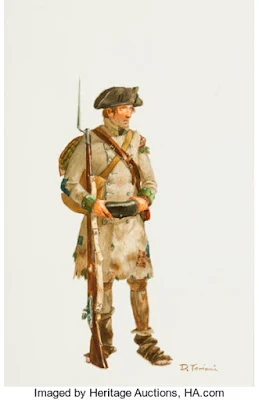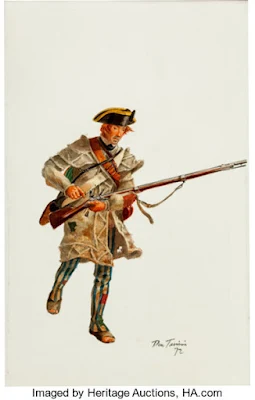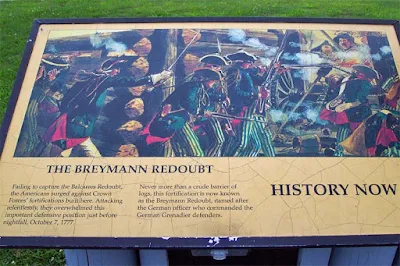I have mentioned before I am on the Fife and Drum Miniatures forum. This covers the wars of the 18th century and topics include history, miniatures, toy soldiers and wargaming. It is a small but enthusiastic group who are well read, knowledgeable and polite. The other day one member Chase (onefootbrush) did an outstanding review of the new Osprey Book by Robbie MacNiven, "Battle Tactics of the American Revolution."
I have curtailed my book buying as of late; but after reading his review I had to get this one. Chase's review is what a book review should be and too often are not. I was very happy he allowed me to post his review here. Thank you Chase!
"The book divides into sections based on the armies; British (with Loyalists and Native Allies), Continental (with militias and state troops), German States (sub-divided between Hesse-Cassel and the other German states), and the French Army.
The British section will be familiar to those who have read Matthew Spring's excellent With Zeal and Bayonets. Like Spring, MacNiven documents that the British army adapted into fighting in the North American theater. Famously, at the micro-tactical level the British army adopted two ranks with more spacing between each file of soldier (open order, extended order) and at the macro-tactical level the British army largely did away with having multiple lines and a reserve, usually have a small reserve if any at all and deploying their troops into a single line to maximize frontage. MacNiven emphasizes that extended frontage was very important to the often outnumbered British army but became a liability as the American rebels became more disciplined and mastered use of the bayonet (notably Cowpens). MacNiven also argues that it is an oversimplification to think of the British army as disdaining musketry and firepower for emphasis on the bayonet or to overstate that Americans focused on accuracy more than their British counterparts.
His section on Native American tactics was particularly informative to me. I was aware of the emphasis on fire and maneuver and little-war skirmishing that dominated Native tactics. However, MacNiven illustrates that Natives fighting in larger engagements preferred a "half-moon" shaped formation. This reminds me of the "Buffalo horns" favored by the Zulu impi, in that the center of the half-moon would engage and fix the enemy while the left and right wings attempted to envelop the enemy flanks. MacNiven also comments that Native commanders avoided completely encircling enemies if they could avoid it, as desperately trapped enemies could inflict heavy casualties that Native commanders attempted to avoid.
Much as in British section might reflect the work of Matthew Spring, the section covering the Continental Army is reminiscent of the work of Robert K. Wright in his book The Continental Army. (For clarification, MacNiven cites both works). MacNiven goes a step further than Wright by addressing the question of whether Patriot troops adopted open order. MacNiven argues that while American forces could and did practice open order, the Continentals in particular displayed a preference for close order formations. He reasons that the Americans, usually outnumbering their British and Loyalist opponents, didn't need the extended frontage. Additionally, Continentals were usually on the defensive and were not as much of a risk of being disrupted by using close order formations in wooded or uneven terrain. There is of course the influence of Stueben's regulations (promoting close order) as well. He also mentions Lt. Col. Mercer's criticism of this reliance on "German" close order tactics with General Wayne's brigade at Green Springs.
Organizationally, MacNiven argues that the Continental Army with permanent brigades and divisions were superior to the ad-hoc tactical brigades that the British used. I'm not sure how convincing of an argument that is, because there were some examples of almost permanent brigade structures used by the British (Webster's brigade of the 23rd and 33rd Regiments in the South comes to mind) and that brigade and division composition did change in the Continental Army. For example, for most of the war, a Continental division was two brigades. However, during the Monmouth campaign, this was changed to three brigades before reverting the following year. Additionally, Washington at Monmouth and in his battle plans for 1779 and later attempted to adopt a European-style of order of battle with multiple lines and wings rather than using the divisions as tactical units, though Washington did end up reverting to division as a combat unit by the time of Yorktown.
In his section on Patriot militia, the author describes that open order and skirmishing of the militia proved useful tactically even if their performances in linear battles were poor (this praise of militia is no doubt to trigger a certain ad nauseam discussion in a certain corner of the internet). He also talks about the legacy of Bunker Hill for both the American Patriots and the Crown troops, with the American attempting to repeat the performance of getting frontally assaulted in favorable positions while the British attempting to maneuver to avoid having to assault frontally fixed positions. Generally the British Army trended towards adopting its formations to the American theater and strategic situation (doing away with multiple lines and reserves), while the Continentals were trending the opposite, emphasizing close order and multiple lines, as they attempted to become a legitimate and respected European-style army.
The remainder of the book shifted to the European allies, the Germans and the French.
The German section breaks down into two competing schools of thought about the tactics of the American situation (and Jaegars). The first is Hesse-Cassel, stubbornly keeping close order and refusing to modify it marching pace, and as a result often being left behind by faster British troops. Conversely, Brunswick conforming to British open order and methods. MacNiven isn't entirely dismissive of Hesse-Cassel's conservativism, pointing out that Hessian commanders felt that with jaegars that the line troops didn't need to adopt open order. Additionally, the musketry of close order troop was thought to be heavier and more effective than open order troops, with MacNiven arguing that the Regiment von Trumbach's close order volley proved decisive in breaking Patriot troops at Savannah at 1778 as compared to the volleys of open order British troops. Additionally, he points out that German Grenadiers were capable of skirmishing in open order in pair with the Jaegar. This they did at Flatbush Pass during the Battle of Long Island.
The section of the French breaks down into theoretical arguments of a French establishment that was reeling from the loss of the Seven Years War. For infantry tactics, advocates of ordre profond (deep assault columns) clashed with advocates of ordre mince (thinner lines), with Rochambeau being a notable member of the latter school. A third order, ordre mixte (mix of troops in column and line) was proposed but still largely theoretical. Rochambeau demonstrated the superiority of ordre mince over ordre profond during a training exercise but was never able to use line tactics in open battle against British troops (using assault columns at Yorktown). MacNiven then illustrates that French troops largely used ordre profond assaults against fortified British positions to mixed results (defeats at Savannah and La Vigie and victories at Grenada and Yorktown). The second argument was largely in French artillery with the school of Gribeauval reforming and overhauling the older system of Valliere.
Spanish troops and their tactics are missing, but I'd imagine they would largely fall into the siege category like the French with Galvez's campaigns against British garrisons in the Gulf of Mexico and Florida and the Siege of Gibraltar.
Overall MacNiven's text provides a compact and succinct overview of the armies and their tactics and I would recommend it as a generalist work. The book is illustrated with tactical maps by Adam Hook which provide a bird eye's view of troops in formation of the battlefield and serve illustrative purposes. To that end the following plates are included:
A. The 33rd Regiment of Foot at Camden. Insets show the men of the 33rd Regiment (in campaign uniform attire) in open order as well as the colour reserve of the 33rd.
B. British Deployment at Waxhaws. Shows the tactical formation adopted by Tarleton during his rapid advance. Inset shows a British Legion infantryman riding double with a dragoon of the 17th Light Dragoons.
C. Ambush at Wyoming. Shows Butler's envelopment by loyalist and Indians against a line of militia and Continentals. Inset shows Seneca warrior and Butler's ranger skirmishing.
D. Patriot Deployments and Movements at Cowpens. Shows Morgan's three lines and the retreat and redeployment of the militia and Continental dragoons in an enveloping action. No inset.
E. Patriot militia attack at King's Mountain. Shows the envelopment and back-and-forth tactics used by the Overmountain men against Ferguson. Inset shows a Patriot militiamen loading a musket behind a tree.
F. Continental Army artillery tactics. Shows a grand battery of Continental six pounders deploying to support a line of infantry. Inset shows limbered Continental gun.
G. Hessian advance at Flatbush Pass. Shows Jaegars and grenadiers in open order screening Hessian close order troops and artillery. Inset shows jaegars operating an amusette.
H. Assault columns in siege warfare. Shows the French and American assault columns on the British redoubts at Yorktown as they approach. Inset shows grenadiers of Gatinais Regiment."
If you are interested in the 18th century I highly recommend the Fife and Drum forum. It can be found here:
https://fifeanddrumminis.proboards.com
















































